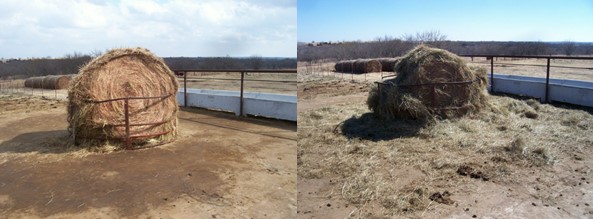
Agricultural News
Hay Feeder Design to Reduce Hay Waste
Tue, 07 Dec 2021 08:29:51 CST
 Weekly, Oklahoma State University Extension Beef Cattle Specialist David Lalman shares his expertise in the cattle industry. This is a part of the weekly series known as the "Cow-Calf Corner" published electronically by Paul Beck. Today, he talks about hay feeder design.
Weekly, Oklahoma State University Extension Beef Cattle Specialist David Lalman shares his expertise in the cattle industry. This is a part of the weekly series known as the "Cow-Calf Corner" published electronically by Paul Beck. Today, he talks about hay feeder design.
Hay production in the Southern Great Plains has steadily increased over the last 50 years. Even though minimizing use of harvested forage would reduce cost of production and carbon footprint in most situations, it is a fact that the haying industry remains an enormous component in the Southern Great Plains agricultural landscape. Therefore, improving hay feeding efficiency represents "low-hanging fruit" in many seedstock and commercial operations.
Feeding strategies for large round bales can basically be separated into use of a hay feeder and rolling bales out. A major advantage to rolling bales out is improved distribution of hay waste and manure over the pasture, which should lead to improved soil fertility. Hoof action is also distributed over a larger feeding area, and this could lead to less soil compaction and (or) less sod/plant damage compared to concentrated feeding areas associated with hay feeders. The disadvantage to relying on unrolling hay is the need to feed every day if standing forage availability is limited. Hay waste is basically a function of the amount of hay provided per animal each day. The more restricted the amount of hay fed, the lower the waste and vice versa. If two or more days' worth of hay must be fed at a time, expect hay waste to exceed 25% of the original bale weight. The term "waste" may be considered a matter of perspective, because the "wasted" hay does provide soil nutrients and organic matter to the system.
Several studies have investigated the influence of hay feeder design on the efficiency of hay utilization and hay waste. The lightweight (and therefore convenient), simple hay ring feeders remain popular for round bale feeding. However, the low original cost and light construction come at the expense of hay feeding efficiency. Researchers have consistently documented 19 to 21% waste, expressed as a percentage of the original bale weight, when these "open" feeders were used (photo). Waste from feeding dry, long-stem grass hay can be reduced to about 12 to 13% simply by purchasing a feeder with a solid sheeted bottom. Finally, in four different experiments, feeders that combine a sheeted bottom feature with some type of a basket or cone mechanism have documented waste of dry grass hay between 3.5 to 8% of the original bale weight.
Efficient hay feeders generally restrict access to the top half of the bale. This limits cows' ability to drag hay from the top of the bale directly onto the pen or pasture surface. Next, the basket or cone mechanism serves to hold the bale in the center of the feeder until it collapses below the basket. Finally, the basket mechanism creates a feeding space inside the feeder so that the cows are not constantly entering and exiting the feeder, dropping hay on the pen or pasture surface.
These features are not without drawbacks, however. First these more efficient hay feeders are going to cost considerably more than the simple, open style feeders. Placing a bale is going to require a tractor with a loader, although some feeders can be filled with a hydraulic truck bed. These more efficient feeders are considerably heavier and cannot be stood up and rolled to a new location as with the open style feeders. Finally, lighter calves may not be able to access the core of the bale in some models. Be sure to explore these potential issues before you purchase a feeder.
Photo: The image on the left is a 1,300-pound bale placed in an "open" steel ring hay feeder. The image on the right is the same bale and feeder after twelve cows had access to the bale for 24 hours.
WebReadyTM Powered by WireReady® NSI
Top Agricultural News
More Headlines...




